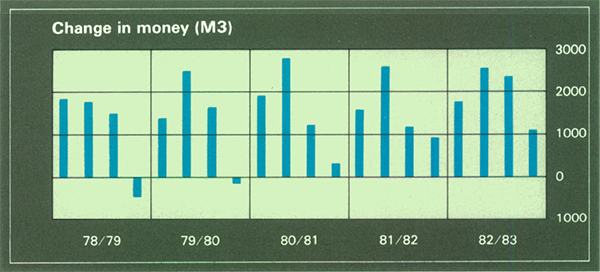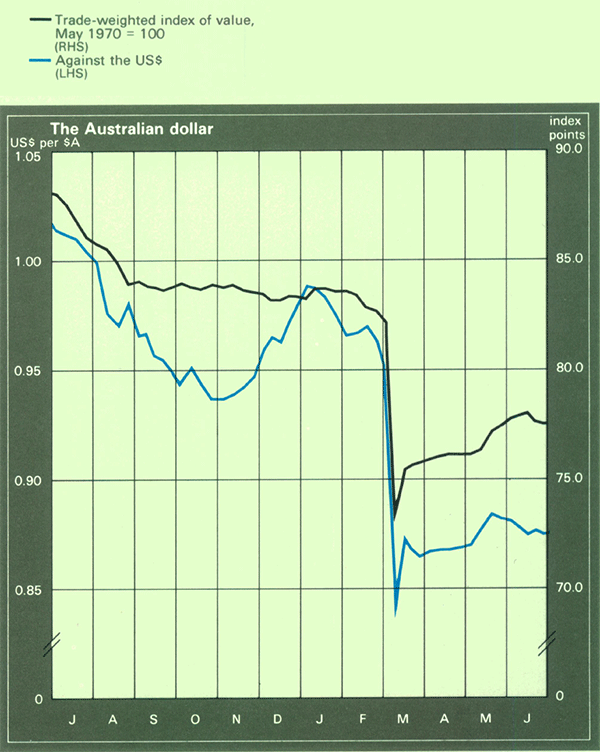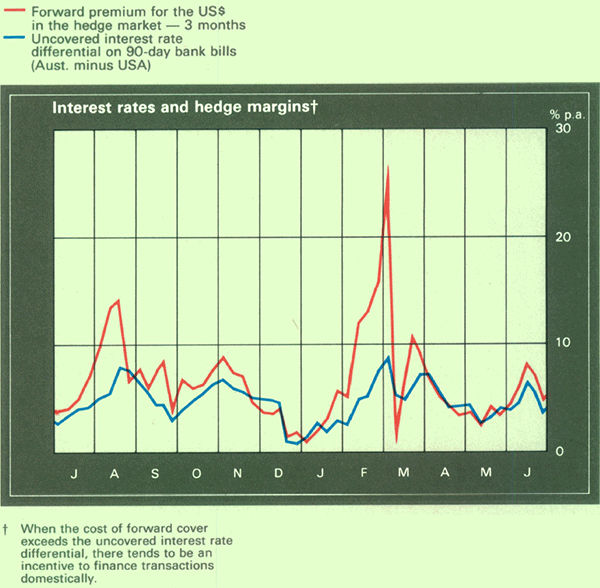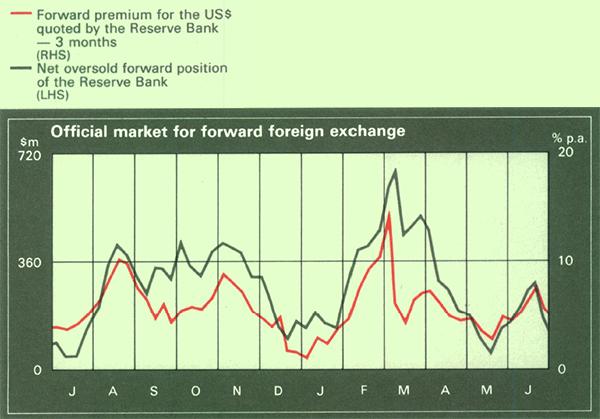Reserve Bank of Australia Annual Report – 1983 The Bank's Market Operations During the Year[*]
The year opened with financial conditions firm. Domestic interest rates were a few percentage points above rates in major foreign centres and the exchange rate of the Australian dollar was continuing to decline gradually. The current account of the balance of payments remained in substantial deficit.
July/August
Conditions stayed generally firm in the early months of 1982/83. Foreign exchange transactions reverted to deficit following the surpluses during the seasonal rundown in liquidity at the end of 1981/82 and, despite additions from Commonwealth budgetary transactions, the private sector's holdings of liquid assets and Commonwealth Government securities (LGS) changed little from their level at end June.
In about mid August financial markets were extremely tight for a few days. The ingredients of this episode were the year's first quarterly instalment of company tax and a low level of “free” LGS in the banking system. At the same time, hedge premiums in forward markets for foreign exchange rose sharply. This meant that there was a substantial rise in the combined cost of borrowing abroad and covering against the risk of a change in the exchange rate prior to repayment.
To help alleviate the temporary tightness in financial conditions, the Bank was very active in this period buying and rediscounting short-term Commonwealth securities and making loans to authorised dealers. It also lent funds under the LGS convention with the trading banks. In view of the disturbed market conditions, the Bank, as a special matter on 19 August, agreed to accept on that day bank bills as collateral for loans to authorised dealers. These moves provided substantial relief to the system but, even so, overnight rates of interest in the unofficial money market rose to around 100 per cent per annum.
Problems for some intermediaries in this period were exacerbated by the fact that their “liquid” resources had been limited almost entirely to short-term private paper and foreign credit lines. The Bank has stressed that the only certain source of cash is assets already within Australia and of a kind which can be exchanged readily with the Bank with minimal change in capital value, such as Treasury notes.
The inaugural tender for Commonwealth bonds was held in August. Yields at this tender were a little above those recorded in earlier secondary trading. However, soon after the tender, yields began a decline which, with a few interruptions, was to continue until the unsettled period surrounding the Federal elections in March. Yields on two-year bonds were about 16 per cent at the end of August and about 12 per cent at the end of January 1983.
Factors leading to the decline included falls in foreign rates of interest, reduced private demand for credit, keen demand for government paper by foreign, particularly Japanese, investors and, perhaps, some optimism about inflation. Local and semi-governmental authorities also benefitted from the favourable market situation and made a quick start with their borrowing programmes, thus reducing their demands on financial markets later in the year.
1. Interest Rates and Financial Aggregates



September to January
In September, private holdings of LGS began a steep climb, with boosts from both the Commonwealth deficit and the capital account of the balance of payments. The rapid expansion in LGS is shown in Graph 1.
Private capital inflow had been below $400 million in each of July and August, but reached around or above $1,000 million in each of the succeeding four months. These inflows more than offset the deficit on the current account of the balance of payments. An aggregate surplus of about $2,200 million in foreign exchange transactions in these months was in marked contrast with the deficit in the corresponding period of the previous year.
The surge in private capital inflows arose from a combination of factors. Interest rates abroad, particularly in the United States, had fallen and were widely expected to fall further. There may also have been some expectations that the Australian dollar was likely to strengthen against the US dollar in the short term. Consistent with this, hedging premiums had also declined and it was more expensive to borrow funds domestically than to borrow abroad on a covered basis. Also at this time, with widespread discussion of rescheduling international debts, severe strains were becoming evident in the international banking system. Relative to some other countries, Australia had probably become a very attractive place to put funds. Against this background, and despite sizable tenders of Treasury notes and a tender of bonds, domestic short-term yields in September fell sharply from the high points of mid August.
| Tender Number | Announced | Amount Offered & Allotted ($m) |
|---|---|---|
| 1 | 29 July 1982 | 350 |
| 2 | 9 September | 675 |
| 3 | 7 October | 700 |
| 4 | 18 November | 800 |
| 5 | 6 January 1983 | 1,100 |
| 6 | 8 April | 500 |
| 7 | 19 May | 1,500 |
| 8 | 30 June | 1,000 |
With foreign exchange transactions in substantial surplus, the decline in the trade-weighted index of value of the Australian dollar (which had commenced in August 1981) was halted in September and the index was little changed for some months. The US dollar weakened in international markets from early in November; with the Australian dollar's trade-weighted index steady the Australian dollar appreciated by about 6 per cent against the US dollar between early November and mid January. Movements in exchange rates and the costs of covering exchange risks are shown in Graph 3.
Changed sentiment about the likely course of exchange rates was reflected in the Bank's dealings in the official forward market. After being, on balance, a net seller of forward foreign exchange since the start of the financial year, the Bank was a net purchaser from early November until mid January. In this period the Bank's net oversold position in forward exchange fell sharply; it was about $440 million early in November and reached a low point of $110 million in the second half of December.
2. Selected Contributions to Change in Money (M3)






After September the Commonwealth's transactions each month added more to (or subtracted less from) the growth in LGS than they had in the corresponding months of 1981/82. Tax cuts, effective from 1 November, were a major factor behind this. In addition, it became apparent soon after August that, mainly due to the effects of weaker-than-expected economic activity on tax receipts and unemployment benefits, the deficit for the year was likely to be considerably above that budgeted.
As a result of the large contributions from both the Government's operations and the balance of payments, LGS increased in the five months to January by about $6 billion, compared with an increase of about $1.4 billion in the corresponding period of the previous year.
In the early part of this period, the desire for firm financial conditions was reflected in the large amounts of both bonds and Treasury notes offered at tenders and in the terms on which the Bank conducted its domestic market operations. As a result partly of the volatility in the Commonwealth's transactions and in foreign exchange flows, there were some occasional periods of severe tightness in markets for short-term funds in October and November. However, the strong surge in short-term capital inflows, arising from favourable interest rate relationships and expectations of a strengthening Australian dollar, led to the need for ever higher sales of Commonwealth securities to retain firm conditions.
With a view to stemming capital inflow, the Bank altered tactics in November and, more particularly, December and pressed less strongly with sales of short-dated Commonwealth paper. It believed that with the economy so slack there would be little risk to the firmness of financial conditions from some reduction in short-term interest rates. In the event, these rates were little changed, on average, in November and then fell sharply in the latter half of December.
With domestic interest rates lower and the Australian dollar appreciating against the US dollar, the external accounts moved closer to balance from mid December. Private capital inflow was much smaller than previously.
In assessing financial conditions, a couple of factors tempered the Bank's concern about the dramatic rise in LGS over these months.
First, a high proportion of the increase was taken up by non-bank groups; of the total increase in LGS in the seven months to January, over three-quarters went to these groups. Despite the much higher increase in total LGS, M3 grew less in the seven months to January than in the same period of the previous financial year. This was due, as well as to the high non-bank take-up of Commonwealth securities, to considerably reduced growth in advances outstanding of the trading banks.
A second feature of the growth in LGS was the high proportion in bonds rather than the more liquid Treasury notes. In all, about four-fifths of the increase in non-official holdings of Commonwealth securities in the seven months to January was in conventional bonds and Australian Savings Bonds (ASB's). These results reflected, respectively, the operation of the tender system for bonds and the fact that the interest rate on ASB's was adjusted only with a lag to the declines in market-determined yields.
3. Markets for Foreign Exchange, 1982/83



| Series Number | Introduced | Coupon Rate (% p.a.) | Withdrawn | Gross Issues ($m) |
|---|---|---|---|---|
| 21 | 31 March 1982 | 13.25 | 2 July 1982 | 745 |
| 22 | 5 July | 14.75 | 19 October | 1,720 |
| 23 | 25 October | 13.75 | 6 January 1983 | 1,368 |
| 24 | 17 January 1983 | 12.25 | 30 June | 1,080 |
February/March
The announcement early in February of Federal elections on 5 March heralded a period of considerable nervousness and volatility in financial markets. There were substantial outflows of short-term capital and liquidity became very scarce.
The outflows of funds were prompted by a widespread view that a sizable devaluation of the Australian dollar was imminent. It seems that many transactions were undertaken with a view to avoiding the possibility of loss and others to reaping a profit from any devaluation which occurred. The most important examples of such actions seem to have been importers accelerating payments, exporters delaying receipts and borrowers replacing foreign borrowings with domestic finance. With reserves falling, the trade-weighted index of value of the Australian dollar was lowered by about 2.5 per cent between the end of January and the first week of March.
Short-term rates of interest increased sharply; for instance, yields on 90-day bank bills rose from around 11 per cent at the end of January to around 18 per cent early in March. However, the cost of hedging the exchange risks involved in borrowing abroad rose even more sharply. Consequently, the cost of covered borrowing in foreign markets became prohibitive. The Bank also raised substantially its premiums in the official market for forward foreign exchange during February; even so, the Bank's net oversold forward position increased.
Yields in secondary trading on Commonwealth bonds also increased but the amount of turnover was small. The sixth bond tender, tentatively scheduled for the second half of February, was deferred.
Gathering turbulence in markets culminated in a severe tightening in financial conditions immediately before and after the elections. Through February and the first week or so of March, the Bank's sales of foreign exchange to banks were over $3,000 million; about two-thirds of this outflow was in the March period. After the payment of company tax in mid February, holdings of “free” LGS by the trading banks fell very low. Their liquidity was maintained partly by bidding for deposits (and inducing a rundown in non-banks' holdings of Commonwealth securities), partly by sales of assets in exchange for LGS from associated savings banks and partly as a result of the Bank's support of the market.
The Bank was very active through this period, alleviating to some degree the short-term stresses in financial markets. While the Bank did not consider it appropriate to make releases from the Statutory Reserve Deposits of the banks to help the system deal with such short-term flows, it extended credit directly to authorised dealers and made loans on special terms under the LGS convention with trading banks. It was also a substantial buyer of Treasury notes and short bonds. These operations were intended to prevent the switch of funds abroad from tightening domestic conditions too severely.
On 8 March, following the elections and change of government, the trade-weighted index of value of the Australian dollar was devalued by 10 per cent. This decision was taken against the background of continuing capital outflow and uncertainty regarding the exchange rate. The Prime Minister-designate announced that the decision had been taken in the light of the unique circumstances and was not intended to signal any change in Government policy on setting the exchange rate.
Events in the following week or so were almost a mirror image of those preceding the devaluation. Capital inflows were very large, just about offsetting the outflows which had recently occurred; short-term rates of interest fell. The Bank became a net purchaser of forward foreign exchange and official forward premiums were reduced. In very liquid conditions, the Bank made substantial sales of securities, while all debt outstanding to the Bank was repaid quickly. In the context of the big inflows of foreign exchange, the trade-weighted index of value of the Australian dollar was appreciated by 3 per cent in the week following the devaluation. Immediately after this, net flows of foreign exchange became smaller and financial markets more settled.
Some indications of the swings in financial quantities and prices during this episode and of the Bank's operations are provided in the table below and in Graph 3.
| Five weeks† prior to devaluation | One week* after devaluation | ||
|---|---|---|---|
| 1. | RBA's transactions in foreign exchange with banks (sales –) | −3,265 | 2,798 |
| 2. | Change in RBA's loans outstanding to authorised dealers and to banks | 1,280 | −1,288 |
| 3. | RBA's net dealings in CGS with non-official sector | ||
| – purchases/rediscounts | 2,319 | — | |
| – sales | 302 | 1,491 | |
| 4. | RBA's new transactions in forward foreign exchange (sales –) | −439 | 174 |
| † During the five weeks to 9 March (7 March for item 4) * During the week to 16 March (14 March for item 4) |
|||
Over this six-week period total LGS rose by about $750 million, largely reflecting net outlays of the Commonwealth. There was little net change in holdings of LGS by non-bank groups; a fall prior to devaluation was offset by a slightly larger increase immediately after. Banks bid strongly for funds through the period – to support the increased demand for their advances in the pre-devaluation period, and, after devaluation, to restore their “free” LGS to comfortable levels with payments of provisional and company tax imminent. It is probable that the February/early March experience led banks to seek a larger level of “free” LGS than they might otherwise have done.
June quarter
For most of April and May foreign exchange transactions were again in surplus. The trade-weighted index of value of the Australian dollar was fairly steady during April. With declines occurring in forward premiums and slight falls in interest rates in the United States, covered borrowing abroad was at times attractive during this month and the first half of May. The Bank was a net purchaser of forward foreign exchange and its net oversold position fell to about $40 million in mid May.
Against this background the trade-weighted value of the exchange rate was raised and flows of foreign exchange, after some initial outflows, moved closer to balance in the second half of May. The Bank became once more a modest net seller of forward cover and its forward premiums were increased.
The inflow of foreign funds allowed payments of provisional and company tax in April and May to be made with only moderate upward pressure on short-term interest rates. The Bank was active in smoothing the necessary transfers of funds from the private sector to the Commonwealth but not abnormally so for that time of the year.
Bond yields in secondary trading had risen in February and March but resumed their previous downward trend in April. Reduced yields in secondary trading were confirmed in the results of a modestly-sized tender in the middle of that month. The final tender for 1982/83 in late May was a large one of $1,500 million; yields rose in the tender and further in secondary trading soon after.
Financial conditions tightened in the period from mid May to mid June. This change was associated with the need to make settlements for bonds won at the tender, nervousness about possible tightness in markets around the end of the financial year and some outflows of foreign exchange. These flows were, in turn, associated with rises in interest rates in the United States and expectations of a strengthening US dollar. Premiums in markets for forward foreign exchange were increased, putting further upward pressure on domestic rates of interest. The Bank was a net buyer of Commonwealth securities over this period.
To allay concern that large flows of funds to and from the Government around end June might add to the unsettled state of markets, the Bank informed the major trading banks that loans under the LGS convention on especially short and flexible terms would be available during that period.
In the event, the US dollar became weaker over the latter part of June and apprehension about end-year tightness in domestic markets abated. Foreign exchange transactions were in surplus and domestic market yields, including bond yields, declined from their mid-month levels. The banks had no need of recourse to the Bank.
The trade-weighted index of value of the Australian dollar showed little net change during June, with increases early offset by decreases later. Over the course of the year as a whole the trade-weighted index was reduced by 11.9 per cent, while the US$/$A rate fell by 14.5 per cent.
Footnote
Detailed quarterly surveys of the Bank's market operations during 1982/83 appeared in the November 1982, February, April and July 1983 issues of the Bank's Bulletin. [*]